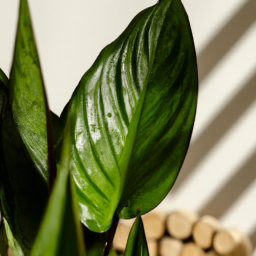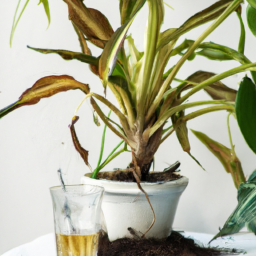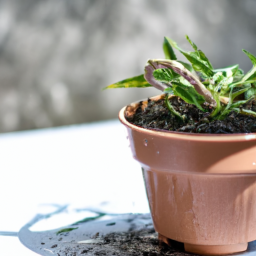
Have you ever wondered how indoor plants are able to thrive without direct sunlight? It may seem like a mystery, but there are actually several factors at play that allow indoor plants to grow and flourish even in low-light conditions. In this blog post, we will explore the fascinating world of indoor plants and answer the question: How Do Indoor Plants Grow Without Sunlight? Let’s dive in and uncover the secrets behind the greenery that brightens up our homes and offices.
Benefits of Growing Indoor Plants Without Sunlight
Indoor plants are a great way to add a touch of nature to your home or office, but not all indoor spaces receive enough sunlight to support plant growth. Fortunately, there are ways to grow indoor plants without sunlight, allowing you to enjoy the benefits of greenery even in low-light environments.
Increased Air Quality
One of the key benefits of growing indoor plants without sunlight is the improvement in air quality. Plants are natural air purifiers, absorbing carbon dioxide and releasing oxygen through the process of photosynthesis. Even in low-light conditions, plants can still perform photosynthesis to some extent, helping to filter out toxins and pollutants from the air.
Indoor plants also release moisture through a process called transpiration, which can help to increase humidity levels in dry indoor environments. This can be particularly beneficial during the winter months when indoor heating can cause the air to become dry and stale.
In addition to improving air quality, indoor plants can also help to reduce stress and promote a sense of well-being. Studies have shown that being around plants can have a calming effect on the mind and body, helping to reduce feelings of anxiety and fatigue.
Low Maintenance
Another benefit of growing indoor plants without sunlight is that they are generally low maintenance. While most plants do require some level of light to survive, there are several varieties that can thrive in low-light conditions, making them ideal for indoor spaces with limited natural light.
Some examples of low-light indoor plants include snake plants, pothos, and peace lilies. These plants are well-suited to indoor environments and can survive with minimal care, making them perfect for busy individuals or those with a black thumb.
By choosing the right plants for your space and providing them with the proper care, you can enjoy the benefits of indoor greenery without the need for direct sunlight.
Creative Planting Solutions
Growing indoor plants without sunlight also opens up a world of creative planting solutions. In low-light environments, you can experiment with different plant varieties, containers, and growing techniques to create unique and visually appealing displays.
For example, you can create a vertical garden using hanging planters or wall-mounted shelves to maximize space and add a touch of greenery to your walls. You can also mix and match different plant varieties to create interesting textures and colors in your indoor garden.
By thinking outside the box and exploring new ways to grow indoor plants, you can transform your space into a lush and vibrant oasis, even without direct sunlight.

Best Indoor Plants That Thrive in Low-Light Environments
As an expert in indoor plants, I understand the importance of finding the right plants that can thrive in low-light environments. While most plants require sunlight to photosynthesize and grow, there are certain varieties that can survive and even thrive in dimly lit spaces. In this guide, I will share with you some of the best indoor plants that can grow without sunlight and provide you with tips on how to care for them.
Snake Plant
The snake plant, also known as Sansevieria, is a popular choice for low-light environments due to its ability to survive in almost any condition. This hardy plant is perfect for beginners as it requires minimal care and can thrive in low light. The snake plant has long, sword-shaped leaves that can grow upright or in a rosette pattern, adding a touch of greenery to any room.
To care for a snake plant, place it in a spot with indirect sunlight and water it sparingly, allowing the soil to dry out between waterings. This plant is also known for its air-purifying properties, making it a great addition to your home or office space.
In addition to its low-light tolerance, the snake plant is also drought-resistant and can survive long periods without water. This makes it an ideal choice for those who may forget to water their plants regularly.
ZZ Plant
The ZZ plant, or Zamioculcas zamiifolia, is another excellent choice for low-light environments. This plant has glossy, dark green leaves that add a touch of elegance to any room. The ZZ plant is known for its ability to thrive in low light and can even tolerate neglect, making it a great option for busy individuals.
To care for a ZZ plant, place it in a spot with indirect sunlight and water it sparingly, allowing the soil to dry out between waterings. This plant is also drought-tolerant and can survive long periods without water, making it a low-maintenance option for indoor gardening.
The ZZ plant is also known for its air-purifying properties, making it a great choice for improving indoor air quality. This plant is also pet-friendly, making it safe to have around pets and children.
Pothos
Pothos, also known as Devil’s Ivy, is a versatile plant that can thrive in low-light environments. This plant has heart-shaped leaves that come in a variety of colors, including green, golden yellow, and variegated patterns. Pothos is a popular choice for hanging baskets or trailing down shelves, adding a touch of greenery to any space.
To care for a pothos plant, place it in a spot with indirect sunlight and water it when the top inch of soil feels dry. This plant is also known for its air-purifying properties, making it a great addition to any room in your home or office.
Pothos is a fast-growing plant that can quickly fill up empty spaces with its lush foliage. This plant is also easy to propagate, making it a great option for beginner gardeners looking to expand their plant collection.

How Do Indoor Plants Grow Without Sunlight
Tips for Providing Adequate Light for Indoor Plants Without Sunlight
Understanding the Importance of Light for Indoor Plants
Light is essential for the growth and development of indoor plants. It is the primary source of energy for photosynthesis, the process by which plants convert light into food. Without an adequate amount of light, indoor plants may struggle to thrive and may exhibit symptoms such as yellowing leaves, stunted growth, and poor flowering.
While sunlight is the most natural and effective source of light for plants, not all indoor environments receive sufficient sunlight. In such cases, it is important to provide alternative sources of light to ensure the health and vitality of indoor plants.
Understanding the light requirements of different plant species is crucial for providing the right amount and type of light for optimal growth. Some plants may require more light than others, while some may be able to thrive in low light conditions.
Choosing the Right Light Source for Indoor Plants
When natural sunlight is not available, artificial lighting can be used to provide the necessary light for indoor plants. There are several types of artificial lighting options available, including fluorescent, LED, and incandescent lights.
Fluorescent lights are a popular choice for indoor plants as they are energy-efficient and provide a good spectrum of light for plant growth. LED lights are also a great option, as they are long-lasting and can be customized to provide the specific light spectrum needed for different plants.
When choosing a light source for indoor plants, it is important to consider the intensity, duration, and quality of light provided. Plants that require more light may need to be placed closer to the light source, while plants that require less light can be placed further away.
Tips for Providing Adequate Light for Indoor Plants
1. Position indoor plants near windows or glass doors to maximize natural light exposure.
2. Use reflective surfaces such as mirrors or white walls to bounce light onto plants.
3. Rotate plants regularly to ensure even light distribution and prevent growth towards one direction.
4. Consider using grow lights or light bulbs specifically designed for plant growth to supplement natural light.
5. Monitor plant growth and adjust light exposure as needed to prevent overexposure or underexposure.
6. Avoid placing plants in direct sunlight for extended periods, as this can cause sunburn and damage to leaves.
In a Nutshell
Have you ever wondered how indoor plants manage to grow and thrive without direct sunlight? It may seem like a mystery, but the truth is that indoor plants have adapted to survive in low-light conditions. While sunlight is essential for photosynthesis, the process by which plants convert light into energy, indoor plants have evolved to make the most of the limited light available to them.
Indoor plants are able to grow without direct sunlight by maximizing their use of available light through a process called phototropism. This means that plants are able to bend and stretch towards the light source in order to capture as much light as possible. Additionally, indoor plants have developed the ability to store energy and nutrients for longer periods of time, allowing them to survive in low-light environments. So next time you marvel at your thriving indoor plant collection, remember that these plants have some pretty impressive survival strategies up their sleeves!
Q&A Corner:
Q1: Can indoor plants grow without sunlight?
A1: Yes, indoor plants can grow without direct sunlight. There are many varieties of plants that can thrive in low-light conditions, such as snake plants, pothos, and peace lilies.
Q2: How do indoor plants grow without sunlight?
A2: Indoor plants can grow without sunlight by using artificial light sources, such as grow lights or fluorescent bulbs. These artificial lights provide the necessary light spectrum for plants to photosynthesize and grow.
Q3: What are some tips for growing indoor plants without sunlight?
A3: To help indoor plants thrive without sunlight, make sure to place them near a bright window or use artificial lights. Also, be mindful of watering and humidity levels to create a suitable environment for plant growth.
Q4: What are some indoor plants that do well in low-light conditions?
A4: Some indoor plants that do well in low-light conditions include spider plants, ZZ plants, and cast iron plants. These plants are known for their ability to thrive in environments with minimal sunlight.
Q5: How can I ensure my indoor plants are getting enough light to grow?
A5: To ensure your indoor plants are getting enough light to grow, consider rotating them occasionally to expose all sides to light, using reflective surfaces to maximize light exposure, and adjusting the distance between the plants and light source as needed.

James Wong is a renowned ethnobotanist, plant scientist, and local television presenter. With a passion for demystifying plant science, he is known for translating complex botanical concepts into practical advice for everyday plant enthusiasts. James’s expertise spans from traditional gardening to cutting-edge plant technologies, making his insights accessible and informative.


